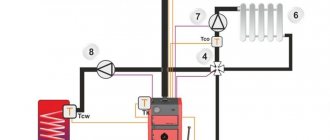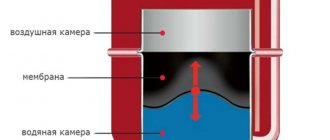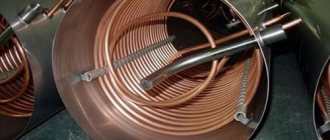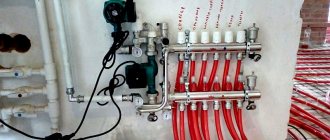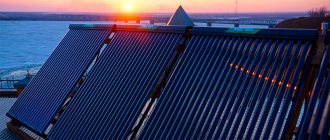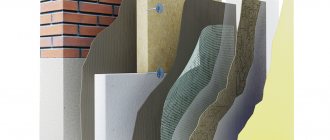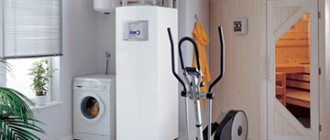The operating principle of infrared heating devices is so simple that one can only wonder why this heating method has become widespread only now. Plus, it is energy efficient and economical. However, many still do not know what infrared heating panels are or what the principle of their operation is.
You will learn everything about the types of IR panels, the specifics of their operation and advantages and disadvantages from the article we presented. We have described in detail the features of their installation and operation. Arguments were given to convince people to purchase infrared heating equipment for decorating their own home.
Operating principle of infrared devices
Heating a room with infrared radiation is a revolutionary method that treats not so much the air itself as the objects in the room. The IR source acts on space like the Sun on our planet.
All other heating methods (batteries, oil heaters, etc.) work on the principle of convection heating of air masses. That is, cold (unheated) air flows around a hot surface and receives heat from it. An increase in temperature entails a decrease in density, as a result, according to the law of physics, air rushes upward.
But we don't live on the ceiling. It is important for us that the comfortable air temperature is in the central and lower third of the room.
There is nothing complicated about the design of IR panels - it’s surprising how humanity didn’t think about their invention earlier! The infrared heat emitted by heaters is similar in power and structure to solar rays
A device that heats not the air, but floors, furniture and even your skin, is an infrared panel. Only after heating of these surfaces is heat transferred to the surrounding air. Heating of the room begins from below, thereby ensuring a comfortable temperature in the area of human activity.
And now those people who are at least a little familiar with physics will have a logical question - why are the heat rays of IR panels not immediately absorbed by the air? This is the whole “trick” of these devices!
In the infrared region there are a kind of “black holes” where heat rays are weakly absorbed. The widest such “window” is located in the range of 8-13.5 microns. If thermal radiation has a wavelength close to it, the air throughput in this case is 80-85%, so IR rays reach the surface unhindered.
Classification of IR heating panels
Depending on the criterion that is taken as the basis for the division, all infrared heating devices are divided into many classes of groups and subgroups.
- According to the method of installation and design, they are divided into:
- Built-in. They are based on plasterboard, on which a heater (graphite thread) and thermal insulation are applied. A decorative protective screen is installed on top of it.
- Mounted. Made of metal, glass, heat-resistant plastic. The heater is encased in anodized aluminum or ceramic.
Built-in models are, as it were, “tied” to building structures or furnishings; wall-mounted types can be used as an independent interior element.
- By type (location) of installation we can distinguish:
- Skirting. They have a long narrow shape, so they are mounted at the bottom of walls (at the border with the floor), under window sills, in niches, etc.
- Wall-mounted. They have a larger heat transfer area than baseboards. They are usually installed in the center of the wall. At the same time, they can be used not only in dry, residential premises, but also in outbuildings - even with high humidity. IR panels are not afraid of moisture and can even be placed in open outdoor gazebos, on verandas, etc.
- Ceiling. They are mounted, as you guessed it, into a suspended ceiling system, and this is their significant advantage. Firstly, they do not spoil the design of the room. Secondly, nothing interferes with the passage of infrared radiation, thus the heat is distributed evenly.
According to the principle of operation, all of the listed types do not differ. They are chosen based on the goals set for the arrangement and the tasks solved during the renovation of the premises.
IR panels built into the suspended ceiling structure are not “conspicuous”, do not take up a single centimeter of usable space, and do not affect the interior design
- Based on wavelength they are distinguished:
- Shortwave. It is characterized by heating above 300 ºС, therefore it is usually used at large-scale production facilities.
- Long wave. “Softer” ones provide a comfortable temperature in living spaces without harming the health of others.
Regardless of the type, infrared heating panels must be installed in such a way that the flow of infrared radiation does not encounter obstacles in its path. The best place for installation will be a section of the wall next to which there is no furniture or decorative items.
Installation of film heating on the ceiling
Installation of infrared heating at home consists of the following steps:
- drawing up calculations for ceiling-type heating equipment;
- ceiling insulation;
- installation of heating parts and temperature sensor;
- connection to the network and thermostat.
Installation of infrared heating on the ceiling
If you want to use infrared heating as the main one, then it should occupy more than 70% of the space. If used as an auxiliary heater, the area will be reduced to 30%. Rolls with thermal insulation are installed end-to-end to the concrete block. Dowels are used as connecting parts. The main thing is that the hat firmly fixes the insulation on the ceiling.
The film is fixed on top of the thermal insulation on the ceiling. An area of 5 cm should be left between adjacent strips. The thermal film is attached in a parallel pattern. For this purpose, copper terminals are used, fixed with copper busbars. The heating terminals are clamped using pliers. In areas of wider cuts, it is supplemented with a bitumen plate. This insulation allows you to close off the terminal areas.
We recommend: Features of infrared plasterboard heating
To connect the floor heating parts to each other, a stranded copper wire is used, the base of which is 2.5 square millimeters. In the area where the thermostat is connected, a groove is made on the wall for laying the wire. Thus, you can easily heat your home using IR ceiling films with your own hands, which will allow you to receive additional savings. An infrared film heater is an innovative solution for high-quality and economical heating of your home.
YouTube responded with an error: The request cannot be completed because you have exceeded your quota.
- Related Posts
- Is there any health risk from infrared heating at home?
- How is film infrared heating installed?
- How to calculate infrared heating?
- Features of industrial infrared heating
- Types of infrared heating panels
- How to organize infrared heating at home?
Scope of application and specifics of operation
IR panels work best with spot heating of a specific place indoors or outdoors. They work great in areas equipped for recreation near dachas and private houses, areas owned by cafes and small restaurants.
Most often, IR panel heaters are used as an additional heating source when it is necessary to increase the temperature in a specific place. For example, when it is necessary to “insulate” a recreation area in a large house or a work space somewhere in a warehouse or industrial facility.
The IR panel allows you to create an “island” of heat in large rooms. Their action is focused, aimed at a certain zone, or more precisely at objects located within it
As for heating commercial buildings in this way, it is very economical and convenient. With the help of panels, it is possible to create conditions for the most comfortable stay of a person in any specific area, without spending money on heating the entire room.
Weather conditions such as humidity or wind do not affect the radiation efficiency, so the panels perform excellently even outdoors.
In offices, infrared panels are often used as the main heat source. This solution is cheaper than installing your own mini-boiler room with solid fuel or gas equipment if the office is not connected to a centralized heating system.
IR heaters are more economical than oil-based heaters, electric heaters, etc., since radiant heating is the most economical among all types of electric heating. It is most profitable for offices to combine heated floors with IR panels mounted in the ceiling. Then you can maintain the room temperature at +20⁰С even in frosty weather.
Infrared heaters emit more than just heat waves. they can easily serve as lamps in the area of entrance areas and in corridors, night lamps
Operating method of infrared heating
In the environment, infrared radiation is present in the spectral region of electromagnetic waves that are emitted by the sun. Thanks to this invisible wave range emitted by it, all living things live and develop on our planet. Scientists divide infrared radiation into three components:
- near,
- average,
- further.
The most productive for heating and safe for living organisms are considered to be electromagnetic waves that go immediately beyond the visible red side of the mid-range. The emission wavelength spectrum varies from 8 to 12 microns. It is the long-wavelength wavelength that developers use when creating infrared equipment and heating systems. Infrared installations are something like the sun in miniature. The only distinguishing feature from the sun is that they constantly heat the room, no matter what the weather is like outside.
Functioning of infrared heating
They operate in domestic conditions from a 220V network. The heating element, which is considered the main part of the device, distributes light radiation. Thanks to the reflector, at the time of operation, the object at which the device is aimed is heated. The role of receivers and emitters can be played by different objects in the room: furniture, windows, floor, ceiling, living organisms. These objects take heat into themselves or transfer it into space.
At the time of operation of the infrared heating system, all surfaces of interior parts in the place of radiation are 10 degrees warmer than the surrounding air. Heating with infrared rays works ideally with other traditional heating options, thanks to which, at minimal cost, you can create a piece of warmth in any room - a place of increased comfort. This type of heating is convenient to use as additional or emergency heating. Heat consumption when using it is no more than 10%.
We recommend: How is film infrared heating installed?
Recommendations for installation
To install infrared heating panels, you do not need special knowledge or experience. The tools needed for installation are at the disposal of every owner. The documents for the device must contain step-by-step installation instructions. If you haven’t found it, go to the panel manufacturer’s website, there is definitely such information there.
Fastenings for panels are already included with them. If you have your own vision on this matter, you can choose the fasteners yourself. However, be sure to make sure that it can support the weight of the panel you choose to install.
Here are a few more nuances that it is better to know about in advance, that is, before installation begins:
- A larger percentage of manufactured panels are ceiling panels. Many of them are equipped with corner brackets, but not all. Therefore, pay attention to this point when purchasing. Swivel models are better because their working surface can rotate 30°.
- For rooms with high ceilings, models are produced that are suspended on chains. This allows you to control the radiation intensity and select the heated area.
- To calculate how powerful the heating system should be to warm the room with IR panels, proceed from the calculation - 1 kW per 10 m2.
- Mount the panels at the recommended mounting height, as most lower wattage panels heat the room more efficiently and evenly by eliminating blind spots and hot spots.
During installation, do not allow the heating surface to come into contact with flammable or flammable substances.
Ceiling infrared devices are supplied with a complete mounting kit. The package includes brackets, hooks and chains depending on the model
Take care of high-quality insulation of electrical wiring contacts when installing the device. Use plastic caps or electrical tape for this.
Infrared thermal film TOOSET 500mm (220W/m2)
Thermal film power 220W/m2
Heating area 100W/m2
Installation type: ceiling/floor
Size 1 linear meters 100×50 cm
Surface temperature, °C 55
Product rating
THE FILM IS SOLD BY LINEAR METERS. THE PRICE IS PER 1 LINEAR METER.
Infrared film is a thermal emitter in the form of a non-woven material, coated on both sides with a plastic film that serves as protection against mechanical influences.
Infrared film is a long-wave type of heater. The heat from these types of heaters is similar to the heat from the sun, but does not contain ultraviolet, microwave or x-ray radiation, so they are safe and very effective.
The film can be used as a main or additional heating system. Using infrared film you can make the floor, ceiling, and walls warm. It is suitable for heating offices, schools, preschool institutions, houses, apartments. Due to the flexibility of infrared film, it can be used to heat not only ceilings, floors, walls, but also to heat columns and uneven interior surfaces.
Korean infrared film Tooset is one of the leaders in the global market. It has a number of features compared to other film manufacturers. PET film of world leaders from Japan and South Korea is used as a basis. This base is practically not subject to transformation when temperature changes. In addition, at the beginning of production, the base undergoes a stage of residual heat shrinkage, which eliminates changes in geometry throughout the entire service life. All this gives a stable maximum power throughout the life of the Tooset infrared film.
High-quality PET film is used as a base, which guarantees resistance to abrasion. This property is especially important when using the film as a heated floor.
Tooset infrared film undergoes triple lamination. This gives a stronger fixation of the internal elements and increases the moisture resistance of the product. This film can be safely used in rooms with high humidity.
Tooset film uses a 15mm wide copper bar. This avoids power losses at the end of long film runs.
Infrared film is made only from high-quality components in South Korea, which is confirmed by a lifetime warranty on the product. In our store you can purchase film at competitive prices and with an official guarantee.
Video review of infrared film TOOSET 500mm (220W/m2)
Video review of installing film under laminate
Video review of installing film on the ceiling
Consumer properties of infrared film TOOSET 500mm (220W/m2)
• Easy installation • Can be installed on floor or ceiling • Lifetime warranty • Absolutely silent operation • Gentle and efficient heat
Complete set of infrared film TOOSET 500mm (220W/m2)
• infrared film (cut by linear meters) • Operating manual with warranty information
Attention: The thermostat and installation kits are not included and must be purchased separately.
Advantages and disadvantages of infrared film TOOSET 500mm (220W/m2)
Advantages: • Classic infrared film with a lifetime warranty. Disadvantages: • There is no self-regulation of power. Furniture cannot be placed on the film • Installation kit must be purchased separately.
Examples of using infrared film TOOSET 500mm (220W/m2)
Installation of TOOSET film on the wall
Attaching film using a stapler
Installation of TOOSET film on the ceiling
Insulating terminal blocks with bitumen tape
TOOSET film under laminate
Installation of TOOSET film on the floor
Mounting kit for infrared film
Infrared film under laminate
Film installation diagram
Instructions, certificates and documents for TOOSET infrared film (download)
Frequently asked questions (FAQ)
What is an infrared heater and is it harmful? An infrared (or IR) heater is a heating element that distributes infrared heat rays that heat the floor, walls and all objects encountered along the way. Having heated themselves, objects begin to heat the air. In the same way, the sun heats the earth. Infrared radiation is absolutely safe for health. This is NOT microwave, NOT radio wave, NOT X-ray radiation and, especially, NOT radiation. This is ordinary thermal radiation, the same as from a fireplace, Russian stove or cast iron radiator. Infrared heaters are approved for use in children's and medical institutions.
Where and for what can infrared film be used? Infrared film can be used to heat rooms as the main heating system or as an additional one. When using film as the main source of heating, its area is selected based on 1 kW per 10 m2. The film is laid under any covering on the floor or ceiling. Depending on your task, if you need to make a warm floor, then accordingly on the floor under the final floor covering. If it is necessary to heat the entire room, then it is installed on the ceiling under the final ceiling covering.
Under what coatings can infrared film be installed? The film can be laid under laminate, lining, linoleum. It is not recommended to install under tiles, as they are solid and will not allow the tiles and subfloor to adhere to each other. Under parquet, because with periodic heating, it can dry out and come apart.
How to lay infrared film on the floor? First, it is advisable to level the floor. Then a foil thermally insulated substrate is spread so that the infrared heat rays are directed upward. Then, using a stapler, the film is secured on either side. Using an installation kit, strips of infrared film are connected to each other by wires, and connected to the network through a thermostat. The film is installed on the floor only in places free from low-standing furniture (refrigerator, bed, closet, etc.).
Is it necessary to use a thermostat with infrared film? In principle, you can use it without a thermostat by connecting the film directly to the network. But there are a number of advantages to using a thermostat. Firstly, it saves energy, since the film will not heat above the set temperature, it will turn on and off only when needed. Secondly, you will not have to constantly go to the outlet or switch when you need to turn the film off or on, everything will happen automatically.
In what form is the film sold and for how many meters is the price indicated? The film is sold in rolls. The price on the website is for 1 linear meter. Accordingly, you can buy from 1 linear meter. This size is 50 cm wide and 100 cm long.
What is the minimum piece of film that can be used, and what power will it have? The film is sold by linear meters; each linear meter can be cut into 4 equal parts along the cut lines. The dimensions of such a piece of film will be 25 cm by 50 cm. The power of such a piece will be 27.5 W.
I want to make a warm ceiling, I have lining there, is it safe and what is the installation principle? Tooset infrared film heats up to a maximum of 55 degrees. Therefore, its use is absolutely safe. The film is laid on the ceiling in the same way as on the floor. First, a foil backing is attached to the rough ceiling, then the film is laid and secured. Next, the film strips are connected to each other by wires using mounting kits, and connected to the network through a thermostat.
What is included in the installation kit? The installation kit includes 2 connectors for connecting wires to the film and 20 cm of bitumen tape. After connecting the wires, the connectors are insulated with pieces of bitumen tape on each side.
Where is it better to place the film for the main heating, on the ceiling or on the floor? For main heating, the ceiling placement of the film is preferable. Floor placement is most often used to create the effect of a “warm floor” rather than for heating. This is explained by the fact that we are forced to limit the floor temperature using a thermostat to a temperature that is comfortable for a person. As a rule, this is no more than 30 degrees. Thus, under no circumstances does the film installed on the floor produce its maximum power. With the help of a thermostat, it turns on and off periodically, but never works all the time. When extreme cold sets in, this power may simply not be enough and you will need to choose between walking on a very hot floor that is not at a comfortable temperature or freezing. The film installed on the ceiling is not limited in temperature and this does not cause any discomfort. In addition, in this case we get warm objects, beds, and even the floor temperature due to the infrared effect will be about 1 degree higher than the air temperature.
What is better, infrared film for the ceiling or a ceiling infrared heater? Both solutions have their pros and cons. The undeniable advantage of infrared film is that it is covered with a decorative covering of the ceiling and is absolutely invisible in the interior. Also, thanks to its low temperature, the film can be installed on very low ceilings (below 2 meters), it will not take up useful space and will not create a burning effect. The disadvantage of infrared film is that if it is not installed properly due to seasonal deformations of the house, it can completely or partially fail. Or you can forget about it and accidentally pierce it with a nail, drill it with a drill, and so on. Such cases are not that uncommon. In this case, you will have to dismantle the entire ceiling to partially or completely replace the infrared film. Conventional ceiling infrared heaters do not have this drawback. They are clearly visible. It is almost impossible to damage them by accident, and if they fail, they are quite easily removed and sent for repair. As for the cost, the final cost of the film is at the level of ceiling infrared heaters in the highest price range. It’s up to you to decide what is right for your situation, but, in any case, both solutions have all the advantages of infrared heaters, namely reliability, efficiency, durability and safety.
Our advantages. Why buy from us?
Help in choosing You can get free professional advice on choosing infrared heaters by calling 8(495)125-1070. Our specialist will tell you in detail about all the features of the product and recommend the optimal model for your conditions. You can also independently calculate the required heater power on our website: “POWER CALCULATION”
Order To purchase the goods you have chosen, you can use the convenient on-line order form on the website or call our managers by phone 8 (495) 125-1070 . For your convenience, the website allows you to order a call. In the upper right corner, click the “ORDER A CALL” button, enter your phone number, and our managers will definitely call you back. Orders are accepted daily from 9 a.m. to 9 p.m.
Payment We accept both cash and non-cash payments. To issue an invoice, send your details by email
Delivery We have some of the lowest prices for delivery of goods in Moscow. We deliver goods throughout Russia. You can find out more HERE
Warranty We fully bear all warranty obligations for the product. You have a guaranteed opportunity to exchange the product or return the money within 14 days from the date of purchase.
Reviews of infrared film TOOSET 500mm (220W/m2)
Arguments for and against IR panels
Those who plan to install infrared heating panels at home naturally want to know not only about their advantages, but also about the points that may cause inconvenience. Therefore, below is an objective assessment of both the positive aspects and disadvantages of this heating method.
The following arguments in favor can be given in favor of infrared panels:
- Impact resistance and increased strength. IR panels are not afraid of even shocks and falls. And all thanks to its shockproof body and heavy-duty materials.
- Easy installation and simple operation. You just need to fix the panel on the wall or ceiling and plug it into a power outlet. This does not require any special knowledge, a welding machine, etc.
- Low energy consumption. Firstly, there are no energy losses for heating the air. Secondly, IR radiation reduces the overall temperature of the space by 3-5 ºС, which allows saving energy up to 25%. That is, the air temperature is felt on average 5 degrees higher than the one shown by the thermometer when measured. And all because not only the air that is being measured heats up, but also the objects in the room and even the person himself.
- Quiet operation. Such heaters will not “crack” or “gurgle”, which means they will not interfere with sleep and other vital processes.
- Independence from power surges. Even if the voltage changes, this will not affect the operation of the heater.
- Maintaining normal air humidity. IR thermal panels do not dry out the air, like other electric convectors, which make breathing difficult and dry out the mucous membranes. They do not allow air mixing (cold/warm), so dust caused by heated air masses does not rise.
- Compact dimensions and lack of associated equipment. There is no need to install bulky pipelines, radiators, boilers.
However, quite often on the Internet you can find information about the dangers of infrared radiation and the negative effects it has on the human body. Such myths have no scientific basis.
Radiant heating benefits from the fact that it evenly warms the room without creating zones of “stagnation” of warm masses
On the contrary, in this sense they are “more useful” than other common heating methods, because:
- do not dry out the air or burn out the air;
- do not raise dust, since there is no convection;
- keep the body in good shape due to the slight temperature contrast.
In addition, such heaters are even recommended for people suffering from joint diseases, since they warm up the human body well, as a result of which inflammation and pain soon go away.
When long-wave infrared rays hit the skin, its receptors are irritated, to which the hypothalamus reacts, the smooth muscles of the blood vessels relax, as a result of which they expand.
Thus, IR rays help stimulate and improve blood circulation. Please note that they are completely harmless to the skin, unlike UV rays, which can even cause pigmentation changes. If you approach the use of IR radiation rationally, it will be difficult to find shortcomings.
Infrared heating panels are not harmful to health. On the contrary, they help cure joint diseases, and it’s not for nothing that they are used in medicine
In cases of poor quality maintenance and negligent use of devices, the following not very pleasant consequences are possible:
- If installed incorrectly, the space will warm up in a different area that would need to be treated first. Infrared radiation is characterized by a clearly limited segment of action.
- An infrared heating system does not always fit harmoniously into the surrounding space.
- Excessive radiation can negatively affect electronics (TV, computer and other electrical appliances). However, it all depends on whether operating standards are met and what dimensions the room has.
Infrared panels are a new generation heating system. It provides safe and efficient home heating with minimal financial costs. You will not encounter any significant drawbacks when installing or using the panels, since they simply do not exist.
“Question-answer” section
On the topic of infrared panels, you can find a lot of identical questions on the Internet, which are the first thing that comes to a person who decides to install them at home. We have consolidated the most common of them and prepared a kind of TOP questionnaire with detailed answers.
– How long will IR panels last me?
– Their average service life is 25 years. Whether they will work for you more or less depends on the mode in which you operate them and whether you follow the care rules.
– What is sold with the IR panel? Are any other materials or components needed for its installation and operation?
– The standard configuration of the device includes the heater itself and a wire with a plug. For subsequent installation and connection, you also need electrical wires, a thermostat in the socket, if it is not structurally provided for, automatic switches, magnetic starters and possibly other automatic devices (depending on the characteristics of the heating system).
You will also need brackets, dowels, screws, and self-tapping screws for fastening, but in most cases they also come as a kit.
– Do panels from different manufacturers have different dimensions or are the standardized dimensions the same for all?
– The length may differ – 1 m and 1.5 m. The first is on models with a power of 0.6 kW, the second is for 1 and 1.3 kW. The width and thickness are the same for all devices - 16.5 cm and 4 cm, respectively.
– What acts as a heating element in the panel?
– It is a low-temperature heating element mounted in an aluminum plate, which acts as a radiator.
– How much does an IR ceiling panel weigh?
– It all depends on the power of the model. For configurations at 0.6 kW, the weight is 3.5 kg, for power 1 and 1.3 kW - 4.5 kg.
– My ceiling is covered with plastic. Will the panel light it up? Does it get very hot?
– Its body practically does not heat up, as it is thermally insulated. Therefore, installation is possible on surfaces made of any materials. You don't have to be afraid of fire.
Infrared heating devices can be mounted on any surface. They work well with any building and finishing materials without the risk of fire
– Is it possible to leave the plates on unattended?
– Yes, if they are equipped with a thermostat. If not, it is not recommended to leave it unattended for a long time to avoid overheating of the room.
– How many thermostats do you need?
– One thermostat per room.
– How much electricity is consumed with such heating? If a model with a power of 1 kW will it “wind up” 1 kW/hour?
– If you approach operation wisely, then, of course, no. The whole secret is that to maintain a comfortable temperature, it is enough for the panel to work for 20-30 minutes per hour.
It is not necessary to monitor the operation of an infrared heating panel equipped with a built-in thermostat or similar device in the outlet. It will turn off automatically when it reaches the temperature selected by the owner.
If you install a thermostat, the heater will not work constantly. It will turn on as needed. If the heating operates for 20-30 minutes per hour, electricity consumption will be from 1/3 to 1/2 of the device’s power.

